![]()
![]()
![]()
Use LEFT and RIGHT arrow keys to navigate between flashcards;
Use UP and DOWN arrow keys to flip the card;
H to show hint;
A reads text to speech;
15 Cards in this Set
- Front
- Back

|
Tripod pitcher (gui) Longshan culture / Shangdao province ca. 3000-1700 BCE earthenware important because: feet and spout suggest it was used to pour hot liquids (likely wine), may have been used in very early forms of ancestor worship rituals. |
|
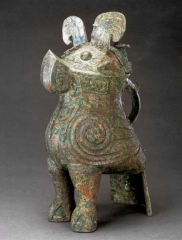
|
Owl shaped wine container (zun) [from the tomb of Lady Fu Hao] Shang Dynasty / Anyang, Henan Province c. 1200 BCE bronze important because: Lady Fu Hao was a consort of King Wu Ding and her tomb was never looted, so it contains a great variety/amount of burial goods. this was probably used for pouring heated wine and incorporates other animals (snakes, a bird, and a dragon) into the owl's form. |
|
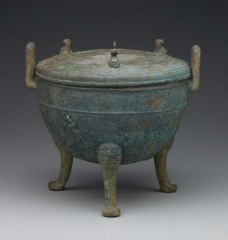
|
Tripod cauldron (ding) Eastern Zhou Dynasty 525-500 BCE bronze important because: this cauldron is an updated version of a standard Shang form - the 3 legs and looped handles are very common. it is decorated with interlaced dragon motifs, which are considered auspicious symbols and would become associated with rulers. this shape is also reminiscent of 9 tripod vessels cast for Yu (founder of the Xia dynasty), which became an emblem of kingship. |
|
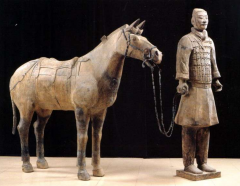
|
Cavalryman and Saddled Horse [from tomb of Qin Shi Huang Di] Qin Dynasty / Lintong, Shaanxi province ca. 210 BCE Terra cotta important because: this figure and horse come from the terra-cotta army of qin shi huang di, made to protect the emperor in the afterlife. this particular warrior is from the "left army" in the 2nd pit, which contained specialized forces like the cavalry, archers, and charioteers. these highly detailed and individualized figures were cast in molds and assembled. |
|
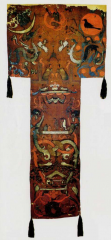
|
Funeral banner [from the tomb of Lady Dai] Western Han dynasty / Mawangdui, Hunan province c.180 BCE color on silk important because: the lady of dai was an aristocratic woman buried with a wealth of material culture. there are several interpretations of the significance of this work; it may have been a mourning banner carried in funerary processions, a "name banner" representing her soul in the afterlife, or have been intended to revitalize her. it was placed on top of her coffin (similar to chu funerary practices). the paired yin and yang imagery painted onto the silk may have been intended to reunite the halves of her soul. |
|
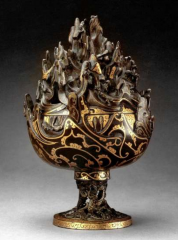
|
Hill-shaped incense burner [from Tomb of Liu Sheng] western Han dynasty / Mancheng, Hebei province c. 113 BCE Inlaid bronze and gold important because: this work has vents hidden among the rocks of the mountains that would create the illusion of mist over mountains when used. there are also small figures, thought to represent the daoist immortals, wandering around the scene. it is one of the earliest representations of shanshui ("mountains and water," or landscape, which would later become the most important genre of painting). |
|

|
Colossal Shakyamuni Buddha [from Yungang Caves] Northern Wei dynasty / Datong, Shanxi province ca. 460 – 465 Sandstone important because: shakyamuni is the historic buddha; here he is shown with his hands in the dhyana mudra/dingyin (meditation). his mandorla (almond-shaped halo) indicates his divinity, and the flames surrounding it have tiny images of buddhas to recall the miracle at shravasti, in which shakyamuni appeared to replicate his body 1000 times to illustrate that existence is an illusion. |
|
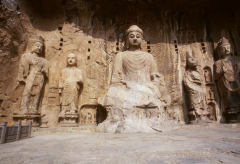
|
Vairochana Buddha Ensemble [from Fenxiang Temple, Longmen Grottoes] Tang Dynasty / Luoyang, Henan province 675 CE Polished Limestone important because: the buddha vairochana is the cosmic buddha from whom the cosmos emanates; he transcends time and space and all other buddhas proceed from him. this particular buddha may have been intended as a comparison to the chinese ruler: empress wu propagated a sutra predicting emergence of chinese chakravartin (universal ruler) who was the secular equivalent of vairochana. the buddha is surrounded by symmetrically arranged arhats/luohans, bodhisattvas, lokapala (world guardian), and dvarapala (gate guardian) |
|

|
Bodhisattva Guide of Souls [ From the Library Cave at Mogao] Tang dynasty / Dunhuang, Gansu province ca. 875-900 Hanging scroll, ink and color on silk important because: this painting is from the library cave at mogao, which preserved a variety of materials including buddhist texts, poetry, and paintings. the depicted bodhisattva may be avalokiteshvara/guanyin (bodhisattva of kindness) who is commonly associated with the western pure land. it illustrates the western pure land buddhist belief that practitioners would be escorted to their rebirth by a bodhisattva or amitabha himself; the presence of a female believer indicates that the sect taught equality. |
|
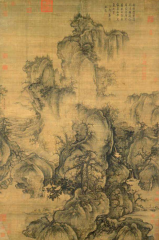
|
Early Spring artist: Guo Xi / Northern Song dynasty 11th century hanging scroll, ink and slight color on silk important because: this work is a monumental landscape with a tall mountain in the BG, low hills in the FG, and tiny figures throughout the composition. the temporality of nature is present in the eroding landscape and precise representation of the season. this painting can be read as an allusion to the confucian hierarchy: the mountain represents the emperor and the hills are his advisors. it is titled, dated, and signed by the artist and features the imperial seal, suggesting that is was commissioned by the emperor himself. |
|
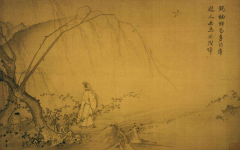
|
On a Mountain Path in Spring artist: Ma Yuan / Southern Song dynasty ca. 1190-1230 Ink on silk important because: this work features an unbalanced composition with great visual continuity and depicts a fleeting moment in time (which would later become a common theme). this piece features a poem and calligraphy by emperor ning zong; the emperor is meant to be represented in both words and images as a humble scholar pausing to watch two birds in flight rather than as his grand self. |
|

|
Six Gentlemen artist: Ni Zan / Yuan dynasty 1345 Hanging scroll, ink on paper important because: Ni Zan sold his house and became itinerant, relying on other's hospitality, and sometimes gave paintings to his hosts as signs of his appreciation. this composition is fairly typical of his body of work: a vertical composition with hills in the BG, negative space in the MG, and rocks/trees in the FG. the dry, pale ink and static compositions gave his work a quality of blandness/plainness (pingdan) that was highly valued in his work. |
|

|
Poetic Feeling in a Thatched Pavilion artist: Wu Zhen / Yuan dynasty 1347 Handscroll, ink on paper important because: wu zhen was a hermit; this work's inscription describes how he built the pavilion himself. the piece depicts an artful arrangement of natural elements to maintain a certain aesthetic while giving the sense of remoteness. two figures/friends face each other inside the pavilion. this painting is done in the dong-ju painting tradition, with alum-lump rocks, vegetative dotting, and hemp-fiber brushstrokes. |
|
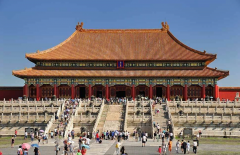
|
Hall of Supreme Harmony, Forbidden City Ming Dynasty / Beijing 1406 (rebuilt Qing dynasty) Wood, plaster, paint, and ceramic tiles important because: the ming emperors used this hall (then known as the fengtian hall) as a location for state banquets and ceremonies for the lunar new year, winter solstice, and emperor's birthday. the qing emperors used it as an audience hall/throne room. it is the most prominent building on the north-south central axis of the forbidden city. |
|
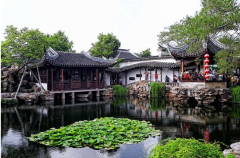
|
Garden of the Master of the Fishing Nets Qing dynasty / Suzhou, Jiangsu province ca. 1765, with later additions garden (wood, tile, lime-plaster and brick walls, rocks, plants, stone, pond) important because: the primary features of chinese gardens are water and rocks, representing yin and yang. urban gardens like this one evoke a retreat from politics/the world (which was in itself a political stance) and elite status of the owner. the dramatically swooping eaves of roof and the ornate woodwork are typical of garden architecture, which was designed to be as visually appealing as possible. |

